In Roth IRA Conversion 2012: A Roth Conversion Calculator I showed how nearly everyone is an excellent candidate for executing a Roth conversion this year. But the exact amount depends on your annual taxable income, age, value of your IRA and how much it appreciates after conversion but before you have to make a decision on how much to keep as a Roth conversion. Because you can always undo part or all of a conversion with a Roth recharacterization, you can’t convert too much.
Here is the calculations for an example of Prof. Low Income:
The Professor expects to have an annual taxable income of just $10,700 this year. He has considerable taxable investments and this amount is solely from investment interest and dividends. Without any conversion, he would be at the lowest 10% tax bracket. He turned 65 years old last year and retired from teaching. He has read Marotta’s optimizing Social Security articles and in his case optimum is waiting until 70 years old. He has a large 403(b) which could be rolled over into an IRA rollover and then converted into a Roth IRA. And there is a teacher’s pension which will also kick in at 70 years old at the latest.
Prof. Low has five years where he will have virtually no income. In five years, Prof. Low will start Social Security as well as begin to take required minimum distribution (RMD) withdrawals from his 403(b)/IRA. By age 70, Prof. Low will be in at least the 15% tax bracket and there is a chance he will be in the 28% tax bracket with over $130,000 in taxable income.
It matters whether Prof. Low will be rising to the 15% or the 28% tax bracket in five years. The row for rising to 28% (3rd row) has much higher hurdles that the account must appreciate than the row rising to 15% (2nd row):
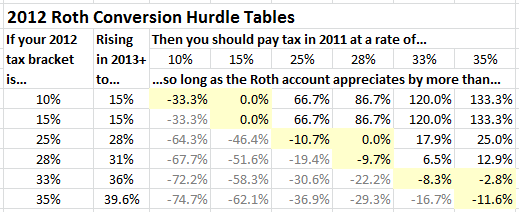
For you math geeks, the formula for the hurdle calculation is:
HurdlePct = (Marginal2011RateYouAreBeingPushedInto / BaseRateYouAreRisingIntoFor2013+) – 1;
for example, your base salary is $10,700. You are in the 2012 10% bracket and will be rising to the 15% 2013+ bracket. You are considering converting as much as possible in the 10% and 15% tax bracket. therefore:
HurdlePct = (0.10 / 0.15) – 1 = -0.333 = -33.3%
Each Roth conversion account can be converted and recharacterized separately so long as the accounts are segregated and kept in separate accounts. Keeping separate piles of money in separate accounts when doing a Roth conversion is called a Roth Segregation. Segregating accounts allow any converted account which drops by more than 11.6% to be recharacterized and not spoil the conversion of the other accounts.
Imagine that Prof. Low converts $300,000 of his 403(b) after rolling it over into a traditional IRA. Then he creates five different Roth Segregation accounts of $60,000 of initial conversion amount each. He then invests each account differently while maintaining a balanced portfolio in aggregate. He might invest one in emerging markets, one in countries with the most economic freedom, a third in US technology, a fourth in US small cap and a fifth in bonds. These different accounts give a greater chance that one account will have excellent returns over the 18 months between the conversion in January of 2012 and the last chance to recharacterize the Roth conversion before he has to file his taxes by the extension deadline in October of 2013.
Here is a table of what amount of the Roth conversion should be kept (in yellow) based on current account values (in tan) assuming he will be in the 15% tax bracket in the future:
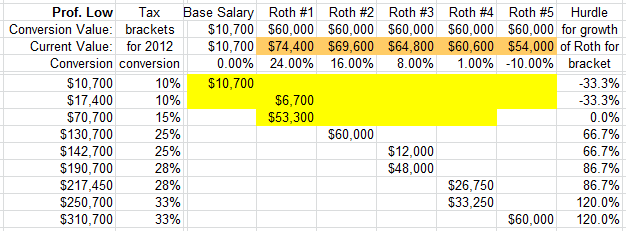
In this example, he only wants to convert $60,000 to bring him to the top of the 15% tax bracket. Since he can always convert in the 15% tax bracket in the future, the hurdle for pushing himself into the 25% tax bracket for 2012 is 66.7% appreciation and that is not likely a return he will get over 18 months. In this case Prof. Low will save $2,495 in future taxes this year:
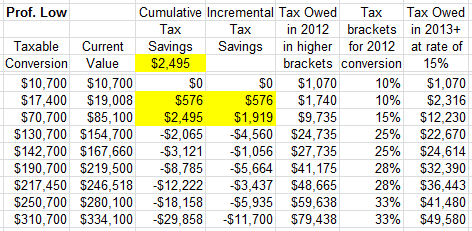
Now notice how the amount he should keep changes with the assumption that he will be in 28% tax bracket in the future:
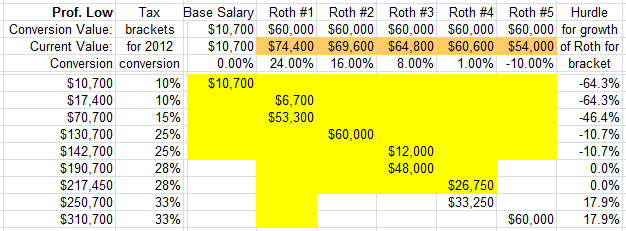
Assuming that Prof. Low is going to be in the 28% tax bracket in five years means he should realize clear through the 2012 28% tax bracket or $217,450 in taxable income for 2012. The tax savings in this case is $18,434:
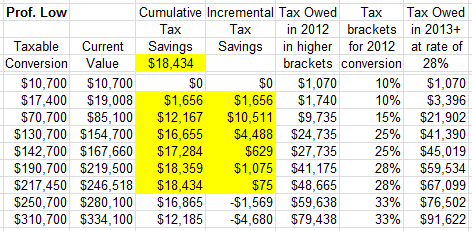
Having non-retirement assets to pay the tax is an important qualification to executing a Roth conversion. This is one of the reasons why we recommend every family save 10% of their pay in retirement vehicles, and an additional 5% in a taxable investment account.
Who would have thought that someone earning $10,700 might want to purposefully push their taxable income up to $217,450 this year in order to pay $47,595 more in taxes at these lower 2012 tax rates?
But this type of tax planning makes sense and saves $18,434 in future taxes.
There is however another option to consider.
In 2012, those in the 10% or 15% tax brackets are allowed to realize capital gains up to the top of the 15% bracket ($70,700) at a zero percent capital gains tax. That means that Prof. Low could realize up to $60,000 in capital gains tax free. He can only do this in 2012. In 2013 there is no zero percent capital gains and it fact the capital gains tax rate rises from 15% to 20%. The savings to Prof. Low would be significant. He would avoid 20% capital gains on $60,000 or $12,000. So this option would be preferable if he will only be in the 15% tax bracket in the future.
You can see why tax planning gets complex.
This example is for illustrative purposes only and we do not recommend executing a Roth conversion without the assistance of a fee-only fiduciary financial planner such as a NAPFA member and a professional tax advisor such as an enrolled agent or CPA.
Subscribe to Marotta On Money and receive free access to a hour long Roth IRA Conversion 2012 Seminar: How to put your money where it will never be taxed again.